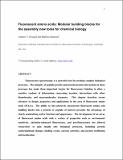Fluorescent Amino Acids: Modular Building Blocks for the Assembly of New Tools for Chemical Biology
Author(s)
Krueger, Andrew T.; Imperiali, Barbara
DownloadWiley_FlAA_final[1].pdf (5.207Mb)
OPEN_ACCESS_POLICY
Open Access Policy
Creative Commons Attribution-Noncommercial-Share Alike
Terms of use
Metadata
Show full item recordAbstract
Fluorescence spectroscopy is a powerful tool for probing complex biological processes. The ubiquity of peptide–protein and protein–protein interactions in these processes has made them important targets for fluorescence labeling, and to allow sensitive readout of information concerning location, interactions with other biomolecules, and macromolecular dynamics. This review describes recent advances in design, properties and applications in the area of fluorescent amino acids (FlAAs). The ability to site-selectively incorporate fluorescent amino acid building blocks into a protein or peptide of interest provides the advantage of closely retaining native function and appearance. The development of an array of fluorescent amino acids with a variety of properties, such as environment sensitivity, chelation-enhanced fluorescence, and profluorescence, has allowed researchers to gain insights into biological processes, including protein conformational changes, binding events, enzyme activities, and protein trafficking and localization.
Date issued
2013-04Department
Massachusetts Institute of Technology. Department of Biology; Massachusetts Institute of Technology. Department of ChemistryJournal
ChemBioChem
Publisher
Wiley Blackwell
Citation
Krueger, Andrew T., and Barbara Imperiali. “Fluorescent Amino Acids: Modular Building Blocks for the Assembly of New Tools for Chemical Biology.” ChemBioChem 14, no. 7 (May 10, 2013): 788–799.
Version: Author's final manuscript
ISSN
14394227
1439-7633